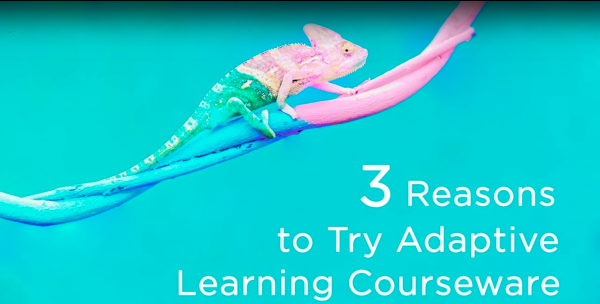Bringing TOPkit Digest to You
|
|
Contents of this Digest:
- Video Tip: 3 Reasons to Try Adaptive Learning Courseware
- Must-Read Announcement: TOPkit Workshop 2020
- Top Tips: Defining Adaptive Learning
- From the Community: Adaptive Learning Courseware Design Principles
- Ask ADDIE: Stages of Quality Design
- Top Community Topics
|
|
VIDEO TIP
|
3 Reasons to Try Adaptive Learning Courseware
|
|

|
|
Click the image above to view a video about how adaptive learning can provide a wealth of opportunities for students, educators, and institutions, as described by Karen Vignare, Dale Johnson, and Patricia O'Sullivan at EDUCAUSE .
|
|
MUST-READ ANNOUNCEMENT
Do you have big dreams for the TOPkit Workshop 2020 on March 4-5 in Orlando, FL? Register now, submit a proposal to present an interactive session, sign up to be a proposal reviewer, or do any combination of these activities.
|
|
TOP TIPS
|
Defining Adaptive Learning from the Bottom Up:
A 5-Step Approach
|
|

|
|
|
Adaptive learning is a nuanced term that garners a considerable amount of attention due to 1) the enigmatic nature of the potentially sophisticated algorithms that power content delivery platforms and 2) the hope that machine learning is, in fact, ‘smart’ enough to guide student learning in a highly personalized and immediately relevant, equitable way as learners seek to progress efficiently and successfully toward content mastery/course completion and, ultimately, graduation.
This couldn’t be more true than at the University of Central Florida (UCF); a university that has invested considerable time and effort over the past few years to be at the forefront of research and practice in this area, facilitated by an internal research team and a Personalized Adaptive Learning (PAL) instructional design team dedicated to constructing adaptive course experiences, while training faculty how to leverage the affordances these adaptive systems provide to offer targeted remediation and content flexibility as their students progress down individualized learning pathways.
As a result of these efforts, the PAL team has formulated five key tenets that describe fundamental ‘Adaptive Learning’ features as they pertain to course design and delivery.
|
|
#1 - Constructing Objective-Based Learning Bits: In order for content and assessment to converge, diverge, and/or repeat, as you would want them to do in any adaptive learning experience, the learning bits you author must be tied to a clearly delineated network of learning objectives (Willcox & Huang, 2017).
|
|
#2 - Authoring Personalized Content and Assessment: After establishing a clear trajectory for your network of objectives, author a (granular) range of content materials, assessment items, and question-level feedback to promote component skill proficiency. Keep in mind that adaptive systems rely heavily on data to drive their recommendation engines, so be sure to author plenty of measurable components (e.g., question sets) to enhance the system’s ability to personalize the student learning experience.
|
|
#3 - Designing (to accommodate) an Adaptive Learning Pathway: To the extent possible, construct a prerequisite (conditional / dependent) network of assessment-driven learning bits to ensure students master certain (potentially rudimentary) skills before proceeding to other (more advanced) topic areas on the learning path. Also, depending on the level of system configuration, consider creating specific rules/behaviors tied to correct or incorrect responses that guide students back (to review) or forward (to accelerate) through the content.
|
|
#4 - Creating Alternative Content to Empower Choice: At UCF in particular, instructors and instructional designers found that relative to traditional courses, adaptive courses needed additional or alternative content (Chen et al., 2017). Additional content involves adding layers of material that can be used to scaffold the learning experience and / or serve as an alternative (multimedia versus textual) form of content that the system can apply to a student’s learning pathway.
|
|
#5 - Developing procedurally generated questions: While content and assessment development certainly require a considerable time commitment, the potential to multiply their value (qualitatively and quantitatively) is an important item to consider when designing an adaptive learning experience. For instance, an instructor’s ability to enhance the learning materials by utilizing string and numeric variables that either randomly generate or get selected from a pool of words or numbers each time the system delivers content or assessments is quite powerful in terms of affording an inclusive and equitable learning environment, which directly touches student engagement and academic performance as well.
Jim Paradiso, Instructional Designer, Center for Distributed Learning, University of Central Florida
|
|
FROM THE COMMUNITY
|
Adaptive Learning Courseware Design Principles
|
 | |
At the University of Central Florida, the Personalized Adaptive Learning instructional designers collaborate with teaching faculty to design and develop courses using adaptive learning platforms. These adaptive learning courses provide students with individualized learning experiences by allowing them progress along their unique learning path through the course content based on learners' needs. We summarized our design principles and best teaching practices in our upcoming paper.
Baiyun Chen, Program Director - Personalized Adaptive Learning, Center for Distributed Learning, University of Central Florida
|
|
|
|
ASK ADDIE
|
Foundations to Skyscrapers: Stages of Quality Design (Issue 17)
|
| |
 |
Our department is working on a foundational framework that will pull together various processes and guidelines faculty encounter when working on developing and implementing their courses and programs…Our faculty development will focus on these as one framework/solution. We would like to do this all within the ADDIE model. What Quality Matters (QM), Worldwide Instructional Design System (WIDS), pedagogy, accessibility, and/or assessment items will come up for them during each stage of the ADDIE model? Signed, Program Framers
|
|
References
Chen, B., Bastedo, K., Kirkley, D., Stull, C., & Tojo, J. (2017) Designing personalized adaptive learning courses at the University of Central Florida. EDUCAUSE Learning Initiative ELI Briefs. Retrieved from: https://library.educause.edu/resources/2017/8/designing-personalized-adaptive-learning-courses-at-the-university-of-central-florida Willcox, K. E., & Huang, L (2017). Network models for mapping educational data.Design Science, 3. Retrieved from https://www.cambridge.org/core/journals/design-science/article/network-models-for-mapping-educational-data/B144B697F0998F36C445054DCA4DEA4F
|
|
Content Coordinator and Contributor
Jim Paradiso, Instructional Designer, Center for Distributed Learning, University of Central Florida Editor
Bren Bedford, Web Project Analyst, Center for Distributed Learning, University of Central Florida
|
|
|




